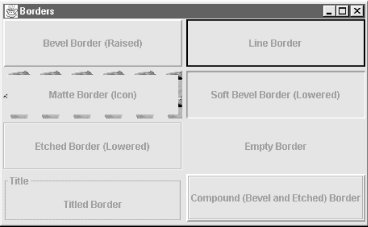Chapter 13. Borders
Borders were one of the most commonly requested extensions to the Java AWT. Swing provides seven unique styles of borders and allows you to “compound” borders to form more intricate combinations. This chapter introduces you to the Swing borders, and shows you how to work with and configure them. At the end of the chapter, we also show you how to create a border of your own.
Introducing Borders
Figure 13.1 shows the standard borders that Swing
provides. There are eight border styles:
Bevel, Soft Bevel,
Empty, Etched,
Line, Matte,
Titled, and Compound.
The MatteBorder gives you two borders in one: the
border area can be filled with a solid color or an icon. (The figure
only shows the icon version; we’ll leave it up to you to
imagine the solid line.)

Figure 13-1. Borders in Swing
You can place a border around any Swing component that extends
JComponent. The JComponent
class contains a border property that is inherited
by all Swing components. (Top-level components that don’t
inherit from JComponent, like
JFrame and JDialog, can’t
have borders.) By default, the border property is
null (no border), but you can access and modify it
using the getBorder() and
setBorder() methods. Once you’ve set a
component’s border, the component always paints itself using
that border, and the insets of the border replace the
component’s default insets.
Here’s how to set a component’s border: ...
Get Java Swing now with the O’Reilly learning platform.
O’Reilly members experience books, live events, courses curated by job role, and more from O’Reilly and nearly 200 top publishers.

